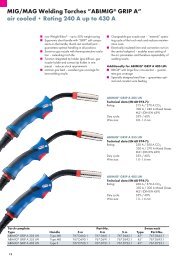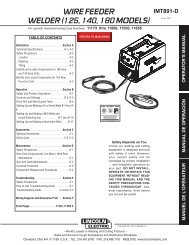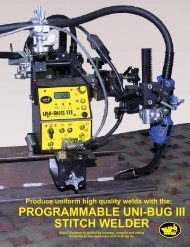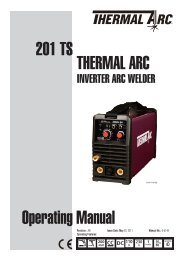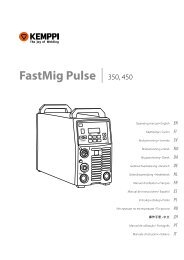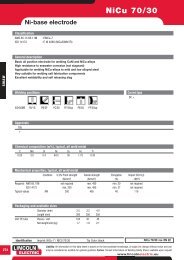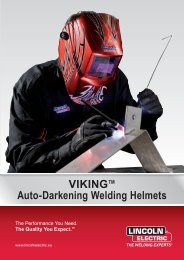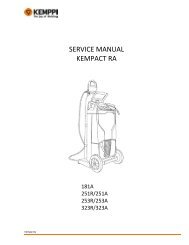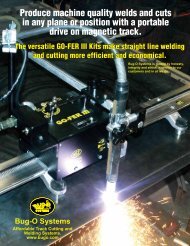mig welding - Rapid Welding and Industrial Supplies Ltd
mig welding - Rapid Welding and Industrial Supplies Ltd
mig welding - Rapid Welding and Industrial Supplies Ltd
You also want an ePaper? Increase the reach of your titles
YUMPU automatically turns print PDFs into web optimized ePapers that Google loves.
Additional Metal Surcharge(s) May ApplyTIPSSteelAs a general statement, steel is readily weldable by the majority of <strong>welding</strong> processes. With alloy steels, it isnecessary to select an appropriate filler metal for the material <strong>and</strong> service situation that the weld will besubjected to. As a guide, carbon content is the first consideration, followed by silicon <strong>and</strong> manganese. If thereare other elements such as chromium, molybdenum etc, then these will usually take priority over carbon.In today’s world, the first thought for <strong>welding</strong> steel is to use the MIG process <strong>and</strong> SIFMIG SG2 wire, or perhapsif a higher UTS is required SIFMIG SG3. In fact, <strong>welding</strong> is symbolised by a MIG welder <strong>and</strong> a ‘shower ofsparks’!Having touched on the MIG process, if deposition rate is important, then Sifcored E71T-1 flux cored wire shouldbe considered. It should also be borne in mind that steel can be MIG brazed, as in the automotive industry onmanganese boron steel with SIFMIG 968. Our other copper alloy wires SIFMIG 8 <strong>and</strong> 328 are also suitable forMIG brazing.TIG filler rods are available for a range of mild <strong>and</strong> alloy steels. A frequently asked question is ‘what do we useon 4130 (0.3C, 0.3Si, 0.5Mn, 1.0Cr, 0.2Mo)’; the answer is Sifsteel A32. With spring <strong>and</strong> high carbon steels,Sifsteel Stainless 312 is often the answer. For joining steel to stainless, consider Sifsteel Stainless 309LSi.It is also worth remembering that TIG brazing with Sifphosphor Bronze No 8, Sifalbronze No 32 or SifsilcopperNo 968 can be very useful with difficult steel applications, dissimilar joints or where heat must be kept to aminimum.The Sifbronze business developed due the ability of Sifbronze No 1, No 101 <strong>and</strong> No 2 to ‘bronze weld’ <strong>and</strong>braze steel, with minimum of distortion <strong>and</strong> producing a neat fillet joint, especially on tubular structures. Perhapswe should also add silver solder for those steel to brass/copper joints. From a gas <strong>welding</strong> point of view, thefiller rod is Sifsteel No 11, which is also referred to as CCMS.Now to arc <strong>welding</strong> electrodes, which come with three different types of coating. The most common <strong>and</strong> popularelectrode, such as Hilco Red Extra, Velveta <strong>and</strong> Velora have a ’rutile’ coating, which is predominantly titaniumoxide to decrease spatter <strong>and</strong> improve slag removal. Cracking in steels is often due to the formation of minutequantities of steam from hydrogen in the electrode combing with oxygen from the air. This can be overcome byusing ‘basic’ coated electrodes (Hilco Basic Super <strong>and</strong> Basic 55), also known as ‘low hydrogen’. Finally, for highdeposition rates, iron powder is added to the coating to substantially increase the amount of material depositedcompared with a rutile type electrode. They are referred to as ‘high recovery’, such as Hilco Regina 160.Cast Iron <strong>and</strong> Super SG Cast IronOxy-Acetylene <strong>Welding</strong> with Super Silicon No. 9Broken castings should be aligned <strong>and</strong> tack-welded into position before pre-heating. All castings must becarefully supported on firebricks with a space of at least three inches beneath <strong>and</strong> preheated in a muffle tobetween 600ºC <strong>and</strong> 800ºC.An oxy-acetylene flame, of ample capacity for the thickness of metal to be welded, is adjusted to a neutralcondition. The edges of the fracture, or the sides of the vee groove, are melted by flame application; a little SIFCast Iron Flux sprinkled in the weld area assists in forming a fluid pool of metal.www.<strong>Rapid</strong><strong>Welding</strong>.comIt is recommended that, on completion of <strong>welding</strong>, the casting should be brought once again to a uniformtemperature of 600ºC-800ºC <strong>and</strong> then allowed to cool very slowly inside the muffle. Cast iron welds correctlymade by the oxy-acetylene process using Super Silicon No. 9 rods can be relied upon to provide a soft <strong>and</strong>easily machinable deposit with full physical properties similar to those of the parent metal.For spheroidal graphite cast iron, follow the above procedure <strong>and</strong> ensure you are using Sif Super SG Cast Iron.134



